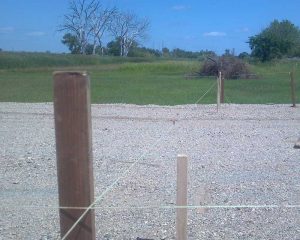Planning a Post Frame Building Upon Sandstone
Reader GEORGE in FARMINGTON writes:
“Mike, in the early stages of planning a pole barn 32’x48’x12′ on a newly acquired piece of property. We’ve cleared the land and found the area we want to erect the building is 100% sandstone. Everywhere we’d have to drill for poles is sandstone as the ground in-between so the sandstone would be the base for the slab as well. Drills real easy but I’m getting conflicting stories from concrete contractors regarding the slab. One says we should “de-couple” the pad from the sandstone by spreading a layer of crushed stone between the sandstone and the slab while another says we should drill into the sandstone and epoxy rebar verticals into it then tie that rebar into the slab rebar. Really don’t know how to proceed as both of these guys appear to be authoritative in their opinions. The de-couple guy claims the sandstone could “heave” the slab up and crack it whereas the other guy says by epoxying vertical rebar to the horizontal rebar, we’ll avoid any issues. Help!”
Mike the Pole Barn Guru responds:
Thank you for reaching out to me. I have never before been faced with building upon sandstone, so I will give you a logical answer and then advice as to what I would do personally.
In regards to our “de-couple” guy’s advice, if the sandstone would heave your slab up on its own, placing a layer of crushed stone between sandstone and slab seemingly would not prevent slab movement in a “heave event”. Rock types such as bedrock, limestone, sandstone, shale and hard chalk have high bearing capacities. These are very strong and good for supporting foundations because of their stability and depth. As long as sandstone is level your slab will be well supported. My question to him would be more of, “What could possibly cause such a heave event?”
From my research, it appears concrete adheres well to sandstone as long as lime is not added to concrete mixture. This seemingly precludes epoxying rebar verticals into it to tie them together.
Now – what I would do. I would search out a Geotechnical Engineer in your area and broach this situation to him or her. This way you get an expert opinion and it should be a reasonably priced solution.
 Contrary to popular opinion, there’s more than one type of gravel and selecting proper size and style is crucial to project success. One most commonly used and versatile type of gravel is #57 crushed.
Contrary to popular opinion, there’s more than one type of gravel and selecting proper size and style is crucial to project success. One most commonly used and versatile type of gravel is #57 crushed. Before any question of construction time can be addressed, let’s eliminate one crucial variable –dirt. Time to lay out a building and dig holes depends upon so many factors. Is the building site level? If it is level, is your building’s prepared pad, actually large enough to place batter boards on? Sites “too tight” to work on will slow everything down.
Before any question of construction time can be addressed, let’s eliminate one crucial variable –dirt. Time to lay out a building and dig holes depends upon so many factors. Is the building site level? If it is level, is your building’s prepared pad, actually large enough to place batter boards on? Sites “too tight” to work on will slow everything down.





